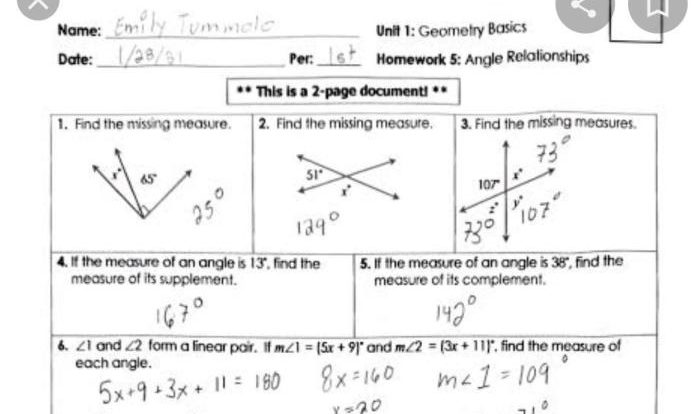Lesson 4.2 Practice A Geometry Answers delves into the fundamental concepts of geometry, providing a comprehensive resource for students seeking to master this essential mathematical discipline. This guide offers a thorough exploration of geometric shapes, their properties, and practical applications, empowering learners with the knowledge and skills necessary to excel in geometry and beyond.
Within this guide, you will find a structured approach to geometry, beginning with a clear explanation of key concepts. Practice problems are meticulously crafted to reinforce understanding, accompanied by step-by-step solutions that illuminate the problem-solving process. Common mistakes are identified and addressed, fostering accuracy and precision in geometric reasoning.
Moreover, real-life applications of geometry are explored, demonstrating the practical significance of this subject in various fields.
Lesson 4.2: Practice A Geometry: Lesson 4.2 Practice A Geometry Answers

This lesson provides an overview of the geometric concepts covered in Lesson 4.2, along with practice problems, solutions, and real-life applications. The concepts include angle measures, triangle properties, and area calculations.
Key Concepts, Lesson 4.2 practice a geometry answers
Angle Measures:Angles are measured in degrees. There are 360 degrees in a full circle. Angles can be classified as acute (less than 90 degrees), right (90 degrees), obtuse (greater than 90 degrees), or straight (180 degrees).
Triangle Properties:A triangle is a polygon with three sides. The sum of the interior angles of a triangle is always 180 degrees. The sides of a triangle can be classified as congruent (equal in length), isosceles (two sides equal in length), or scalene (no sides equal in length).
Area Calculations:The area of a triangle can be calculated using the formula: A = (1/2) – base – height. The area of a parallelogram can be calculated using the formula: A = base – height. The area of a circle can be calculated using the formula: A = π – r^2, where r is the radius of the circle.
Practice Problems
| Problem | Solution |
|---|---|
| Find the measure of the missing angle in a triangle with angles measuring 60 degrees and 75 degrees. | 45 degrees |
| Classify the triangle with sides measuring 5 cm, 5 cm, and 7 cm. | Isosceles triangle |
| Calculate the area of a triangle with a base of 10 cm and a height of 8 cm. | 40 cm2 |
Solutions and Explanations
Solution 1:The sum of the interior angles of a triangle is 180 degrees. Therefore, the missing angle must be 180 – 60 – 75 = 45 degrees.
Solution 2:An isosceles triangle has two sides equal in length. In this case, the triangle has two sides measuring 5 cm. Therefore, it is an isosceles triangle.
Solution 3:The area of a triangle is calculated using the formula: A = (1/2) – base – height. In this case, the base is 10 cm and the height is 8 cm. Therefore, the area is A = (1/2) – 10 – 8 = 40 cm 2.
Common Mistakes
Some common mistakes students make when solving geometry problems include:
- Not understanding the concepts of angles and triangles.
- Using the wrong formula to calculate the area of a triangle.
- Not being careful with units of measurement.
To avoid these mistakes, it is important to review the concepts of angles and triangles, practice using the formulas, and be careful with units of measurement.
Applications in Real-Life
Geometry concepts are used in a variety of real-life applications, including:
- Architecture: Architects use geometry to design buildings and structures.
- Engineering: Engineers use geometry to design bridges, roads, and other infrastructure.
- Surveying: Surveyors use geometry to measure land and create maps.
Geometry is a fundamental subject that has many practical applications in the real world.
FAQ Explained
What are the key concepts covered in Lesson 4.2?
Lesson 4.2 covers geometric concepts such as angle measures, triangle properties, and area calculations.
How can I improve my accuracy and precision in geometry?
Identifying and avoiding common mistakes is crucial for improving accuracy and precision in geometry. This guide provides tips and strategies to help you overcome these challenges.
What are some real-life applications of geometry?
Geometry finds practical applications in architecture, engineering, and various other fields. This guide explores how geometric principles are utilized in everyday life.

